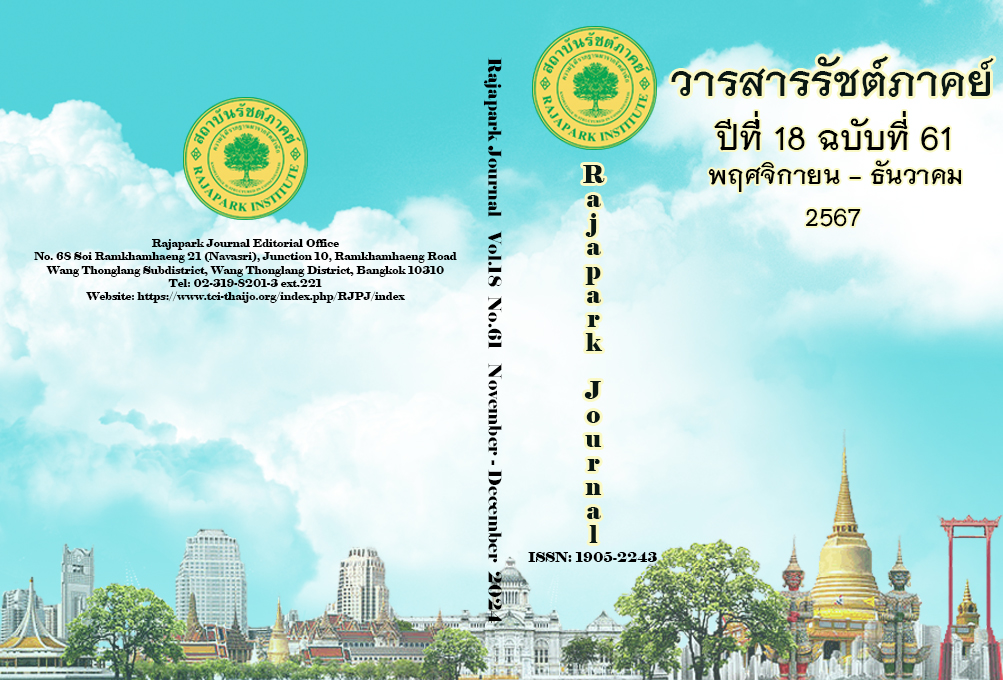Barrier-Free Travel Application for the Disabled in Guangxi
Main Article Content
Abstract
This research aimed 1) to develop a barrier-free travel application for the disabled in Guangxi, 2) to evaluate the quality of the barrier-free travel application for disabled people in Guangxi, and 3) to assess the satisfaction of disabled people in Guangxi with the barrier-free travel application. A quantitative approach is employed, with a sample of 500 participants determined using Taro Yamane’s formula. Data collection is conducted online using the following tools: the Barrier-Free Travel Application, an application quality evaluation, and a satisfaction assessment survey. Descriptive statistics, including mean and standard deviation, are used to analyze the data. The study aims to develop a barrier-free travel application tailored to the needs of individuals with disabilities in Guangxi. The application includes eight essential components: 1) registration and login, 2) accessibility settings, 3) barrier-free travel route planning, 4) locating accessible services and facilities, 5) booking functionality, 6) real-time updates and notifications, 7) social sharing, and 8) feedback and support. Expert evaluations of the application's quality reveal high scores across five main dimensions, particularly in functionality, responsiveness, and compatibility with assistive technologies. The application provides a reliable and user-friendly experience for disabled travelers. Furthermore, a survey of 500 disabled users in Guangxi indicates high satisfaction, with users particularly valuing the content, data security, and availability of customer support. These factors significantly contribute to the positive overall user experience.
Article Details

This work is licensed under a Creative Commons Attribution-NonCommercial-NoDerivatives 4.0 International License.
Views and opinions appearing in the Journal it is the responsibility of the author of the article, and does not constitute the view and responsibility of the editorial team.
References
Buhalis, D., & Darcy, S. (2011). Accessible tourism: concepts and issues. Tourism Planning and Development. DOI:10.1080/21568316.2011.603886
Buhalis, D., & Michopoulou, E. (2021). Information-enabled tourism destination marketing: addressing the accessibility market. Current Issues in Tourism, 14(2), 145-168. DOI:10.1080/13683501003653361
Chen, S. (2023). Research on the requirements and functions of mobile applications for tourism among disabled individuals in China. Lecture Notes in Education Psychology and Public Media, 21(1), 35-41. DOI:10.54254/2753-7048/21/20230043
da Silva Soares Costa, M., Ferreira, C.A.A., & Gavinolla, M.R. (2024). Accessible tourism: a review of recent research trends and future agenda. In Book: Tourist Behaviour and the New Normal, Volume II. DOI:10.1007/978-3-031-45866-8_4
Fan, L., Xiong, Y., Peng, Y. (2024). Assessing accessible travel satisfaction in old communities: a SEM study. Buildings, 14(5), 1273. https://doi.org/10.3390/buildings14051273
Garcia-Romero, A., & Buhalis, D. (2021). The future of accessible tourism in a post-COVID world. Journal of Tourism Futures, 7(1), 2-12.
International Organization for Standardization (ISO). (2018). ISO 9241-11: Ergonomics of human-system interaction—Part 11: Usability: Definitions and concepts. https://www.iso.org/standard/63500.html
Lewis, R. J., & Sauro, J. (2021). Chapter 39: Usability and user experience: design and evaluation. In Book: Handbook of Human Factors and Ergonomics. https://doi.org/10.1002/9781119636113.ch38
Makkonen, T., & Inkinen, T. (2024). Inclusive smart cities? Technology-driven urban development and disabilities. Cities, 154, 105334. https://doi.org/10.1016/j.cities.2024.105334
Marcotte, E. (2011). Responsive web design. A Book Apart.
Nielsen, J. (1993). Usability engineering. Academic Press.
Norman, D. A. (2013). The design of everyday things (2nd, illustrated, revised). The MIT Press.
Petrie, H., & Bevan, N. (2009). The evaluation of accessibility, usability and user experience. Human Factors and Ergonomics. DOI: 10.1201/9781420064995-c20
Shneiderman, B., & Plaisant, C. (2005). Designing the user interface: strategies for effective human-computer interaction. Addison-Wesley.
W3C Web Accessibility Initiative (WAI). (n.d.). Web Content Accessibility Guidelines (WCAG). https://www.w3.org/WAI/
Wen, Y., Li, Y., Yang, Y., & Wang, J. (2023). Towards an evaluation system of disabled individuals’ friendly communities from the perspective of inclusive development—a case study in Jinan. Buildings, 13(11), 2715. https://doi.org/10.3390/buildings13112715
World Wide Web Consortium (W3C). (2019). Web Content Accessibility Guidelines (WCAG) 2.1. https://www.w3.org/TR/WCAG21/
Xia, J., Chen, H., & Wang, X. (2020). Research on the low usage rate of barrier-free facilities from the perspective of disabled people-taking Nanjing as an example. Urban Planning, (12), 47-56.
Yamane, T. (1967). Statistics: An introductory analysis (2nd ed.). Harper and Row.
Zheng, G., & Yang, L. (2022). Report on the cause for persons with disabilities in China. Social Sciences Academic Press. http://www.ssapchina.com/ssapzx/c_00000009000200010014/d_2129.htm


